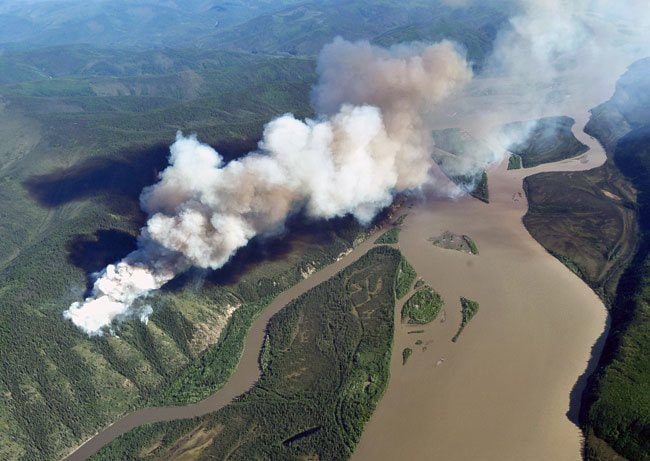The Yukon Flats are on fire.
The area is burning up from wildfires at a rate unprecedented in at least 10,000 years, according to a recent study published in the Proceedings of the National Academy of Sciences.
The Yukon Flats are actually in Alaska, covering a lowland area surrounding where the Porcupine and other rivers join the Yukon River.
With climate models predicting more and more fires in the boreal forest in the coming decades, the researchers wanted to look to an area that is currently burning a lot in hope that it could give us some clues to our future.
The study also gave a snapshot of the past.
The scientists took sediment cores from the bottom of lakes in the Yukon Flats.
The cores are basically “long tubes of mud from the bottom of lakes,” said Ryan Kelly, a PhD student at the University of Illinois and the lead author of the study.
The sediment can be carbon dated to give a picture of what the landscape looked like thousands of years ago.
“We reconstruct the fire history from literally going through the different layers in the core and pulling out charcoal particles that were deposited there when the forest burned in the past,” said Kelly.
The records we have for forest fires in both Yukon and Alaska only go back about 50 years, so to have a record that goes back 10,000 years can provide a lot of valuable information.
The researchers found that while today the flats are burning at a rate of about one fire per 50 years, over the past 3,000 years the average was about one fire every 100 years.
The Medieval Climate Anomaly was one slice of historical time of particular interest to Kelly and other scientists. It occurred about 1,000 years ago.
During that time the earth was warm, maybe as warm as it is today.
And in the Yukon Flats? Kelly found that during the Medieval Climate Anomaly there were lots of fires in the area. Not as many as today, but more than at any other period in the 10,000 year record.
But there was more. Using pollen samples from the sediment, the researchers determined that after fires highly flammable spruce stands were replaced with deciduous species like birch and aspen, which actually cooled fire activity in the area over time.
“As ecologists we like it when we discover these mechanisms by which the ecosystem regulates itself,” said Kelly.
“This seems like pretty good evidence for a feedback where fire affects vegetation and then vegetation in turn affects fire. So we thought that was pretty cool.”
And indeed, in the Yukon Flats today there are few mature spruce stands remaining that could sustain a big fire.
“Most of the places that you look down if you’re flying over it, most of them are either pink with fireweed because they’ve had burns recently - and the spruce trunks are still standing, they’re dead and burned - or they might be past the fireweed stage and it’s into kind of a mix of aspen and some spruce,” said Kelly.
“Even though we think of it as boreal forest, it actually has few stands of spruce, which is the main indicator species for boreal forest, so it’s maybe becoming more of a woodland, which it hasn’t been in the past.”
So will these feedback mechanisms just allow the forest to regulate itself?
It’s hard to say, said Kelly.
In history there have been periods of global warming, but today’s climate change is unprecedented because of both the speed of change and the fact that it is mostly affected by human-caused factors.
“All the models say that in the next century we’re just going to get more and more warming. It’s pretty clear that even if we’re not in a totally unprecedented climate right now, it’s coming pretty soon,” said Kelly.
So although ecosystems have mechanisms to self-regulate, it’s hard to say what’s to come. The way the climate responds to different factors is very complicated, said Kelly.
The boreal forest holds a great deal of carbon within it. When it burns, the carbon is released to the atmosphere.
In this way, warming causes more burning, which causes more warming. That’s a positive feedback loop, said Kelly.
But there are also examples of negative feedback.
A famous study from about five years ago found that dark spruce forests hold onto the sun’s heat more than the light deciduous trees that replace them after a burn, he said.
It found that “that cooling effect could actually offset a lot of the warming effect from the emissions,” said Kelly.
Overall, the research seems to suggest that more burning, on the whole, will cause more warming.
But in an area of unprecedented climate change, it’s hard to say exactly what will happen, said Kelly.
“There’s complicated effects and we have more work to do to figure out all the variables.”
What will the picture look like in the Yukon?
Maybe, at some point in the future, a little bit more like the Yukon Flats.
Models are predicting more fires, bigger fires and longer fire seasons, said Dave Milne, Yukon Wildland Fire Management’s supervisor for the planning and science section.
But there’s a wild card here, too. Warmer air can hold more water than cooler air, which could result in more rain.
Some summers might be warmer and wetter instead of warmer and drier, said Milne.
“We’re already seeing that with these huge rain events in Calgary and Toronto. That’s partly what’s going on.”
Across Canada, climate models are predicting bigger, more expensive fire seasons, but also extreme weather more generally, said Milne.
“Things are going to become more dramatic. There will be more severe weather events - there will be maybe warmer, drier years, maybe warmer wetter years. I don’t know.”
Contact Jacqueline Ronson at
jronson@yukon-news.com
